| Listing 1 - 10 of 12 | << page >> |
Sort by
|
Book
Year: 2005 Publisher: KIT Scientific Publishing
Abstract | Keywords | Export | Availability | Bookmark
 Loading...
Loading...Choose an application
- Reference Manager
- EndNote
- RefWorks (Direct export to RefWorks)
Shallow turbulent wake flows are generated by large obstacles - like islands or headlands - introduced to shallow turbulent open-channel flows. Large-scale quasi two-dimensional vortices may shed off from an obstacle, and advect downstream in a vertical shear flow with predominantly small-scale turbulence induced by bottom friction. Experimental, analytical, and numerical techniques are employed in the present study to characterize the mean flow and turbulence properties of shallow wakes; mechanisms of generation and decay of large-scale vortical structures are clarified, as is their influence on momentum and mass transport in shallow wakes; the global and local stability of shallow wakes is analyzed and evidenced from experimental data. Part I of this work covers non-intrusive optical measurement techniques especially adapted to investigate shallow shear flows. Flow velocities and mass concentrations are obtained (i) point-wise with high spatiotemporal resolution using a combinded LDV-LIF system, and (ii) field-wise using near-surface PIV and depth-averaged PCA systems with a coupling by phase-resolved averaging. Improved algorithms for the evaluation of mass concentrations are based on hydro-optical models of the underlying fluorescence and light attenuation processes. Part II addresses the time-mean description of shallow wake flows. The stochastic description of the turbulence fields displays a characteristic spectral distribution both of kinetic energy and of mass variance, which is partially consistent with the theory of unbounded 2D turbulence at large scales, and with the theory of homogeneous 3D turbulence at small scales. An integral wake model including the effect of bottom friction is derived analytically, and is validated by experimental data. The time-mean distributions of flow velocities and of mass concentration allow to identify wake near fields and far fields with specific asymptotic wake developments. Wake stability classes are associated with local stability regions suggested by linear stability analyses. Part III elaborates the structure and dynamics of quasi-periodic wake flows and the significance of large-scale eddies. This involves a structure identification scheme to educe individual vortices, and a phase-resolved averaging procedure to decompose the flow fields into large-scale coherent and small-scale turbulent parts. A Numerical Particle Tracking technique is employed to model the mass transport and to elucidate different diffusion and dispersion effects.
vortex street --- wake flow --- flow measurement --- LIF --- shallow water --- turbulence --- coherent structure --- PCA --- mass transport --- light absorbtion --- PIV --- LDV --- light absorption
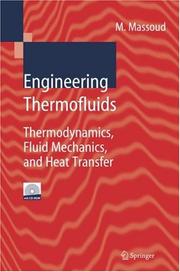
ISBN: 3540272801 3540222928 Year: 2005 Publisher: Berlin, Heidelberg : Springer Berlin Heidelberg : Imprint: Springer,
Abstract | Keywords | Export | Availability | Bookmark
 Loading...
Loading...Choose an application
- Reference Manager
- EndNote
- RefWorks (Direct export to RefWorks)
The "Engineering Thermofluids" is a unique textbook, which brings the three pillars of thermal sciences; thermodynamics, fluid mechanics, and heat transfer under one umbrella. These three distinct, yet intertwined subjects are treated in an integrated manner. The primary audiences for this book are senior undergraduate, graduate, and practicing engineers in the fields of aeronautical, chemical industrial, mechanical, and nuclear engineering. Topics are discussed in detail while still using a simple and easy to follow approach. Numerous walk-through examples are solved and illustrations are provided to guide the reader through more subtle topics. Each chapter starts with a section for the introduction of various terminologies used. The chapter on thermodynamics covers the first law, the second law, the power cycles, and the mixture of gases. The chapter on fluid mechanics covers both steady-state and transient single phase-flow as well as two-phase flow. The chapter on heat transfer covers conduction, convection, radiation, boiling, and condensation. These chapters are followed by the chapter on applications of the engineering thermofluid, which covers the design and operations of various heat exchangers, turbomachines, and flowmeters. Many practical design problems are either solved or provided as homework. Practicing engineers will find this book a useful text to have around for the many practical problems and solutions, illustrations, definitions, methods, tables, and figures provided. The preference throughout the text is on obtaining analytical solutions of a closed form. Numerical solutions as well as experimental results are presented when analytical solutions cannot be found.
Thermodynamics. --- Fluid dynamics. --- Heat --- Transmission. --- Chemistry, Physical and theoretical --- Dynamics --- Mechanics --- Physics --- Heat-engines --- Quantum theory --- Heat transfer --- Thermal transfer --- Transmission of heat --- Energy transfer --- Fluid mechanics --- Engineering. --- Chemical engineering. --- Hydraulic engineering. --- Engineering Thermodynamics, Heat and Mass Transfer. --- Industrial Chemistry/Chemical Engineering. --- Engineering Fluid Dynamics. --- Energy Systems. --- Energy, general. --- Engineering, Hydraulic --- Engineering --- Hydraulics --- Shore protection --- Chemistry, Industrial --- Engineering, Chemical --- Industrial chemistry --- Chemistry, Technical --- Metallurgy --- Construction --- Industrial arts --- Technology --- Heat engineering. --- Heat transfer. --- Mass transfer. --- Fluid mechanics. --- Energy systems. --- Energy. --- Mechanical engineering --- Thermodynamics --- Hydromechanics --- Continuum mechanics --- Mass transport (Physics) --- Transport theory
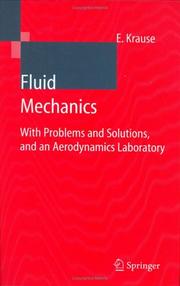
ISBN: 3540272232 3540229817 3642061885 Year: 2005 Publisher: Berlin, Heidelberg : Springer Berlin Heidelberg : Imprint: Springer,
Abstract | Keywords | Export | Availability | Bookmark
 Loading...
Loading...Choose an application
- Reference Manager
- EndNote
- RefWorks (Direct export to RefWorks)
Despite dramatic advances in numerical and experimental methods of fluid mechanics, the fundamentals are still the starting point for solving flow problems. This textbook introduces the major branches of fluid mechanics of incompressible and compressible media, the basic laws governing their flow, and gasdynamics. "Fluid Mechanics" demonstrates how flows can be classified and how specific engineering problems can be identified, formulated and solved, using the methods of applied mathematics. The material is elaborated in special applications sections by more than 200 exercises and separately listed solutions. The final section comprises the Aerodynamics Laboratory, an introduction to experimental methods treating eleven flow experiments. This class-tested textbook offers a unique combination of introduction to the major fundamentals, many exercises, and a detailed description of experiments.
Continuum mechanics. --- Fluid mechanics --- Mechanics of continua --- Elasticity --- Mechanics, Analytic --- Field theory (Physics) --- Hydraulic engineering. --- Chemical engineering. --- Engineering. --- Engineering Fluid Dynamics. --- Classical and Continuum Physics. --- Industrial Chemistry/Chemical Engineering. --- Engineering Thermodynamics, Heat and Mass Transfer. --- Automotive Engineering. --- Construction --- Industrial arts --- Technology --- Chemistry, Industrial --- Engineering, Chemical --- Industrial chemistry --- Engineering --- Chemistry, Technical --- Metallurgy --- Engineering, Hydraulic --- Hydraulics --- Shore protection --- Fluid mechanics. --- Continuum physics. --- Thermodynamics. --- Heat engineering. --- Heat transfer. --- Mass transfer. --- Automotive engineering. --- Heat --- Mechanical engineering --- Thermodynamics --- Chemistry, Physical and theoretical --- Dynamics --- Mechanics --- Physics --- Heat-engines --- Quantum theory --- Classical field theory --- Continuum physics --- Continuum mechanics --- Hydromechanics --- Mass transport (Physics) --- Transport theory --- Heat transfer --- Thermal transfer --- Transmission of heat --- Energy transfer --- Transmission.
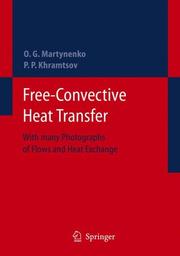
ISBN: 1280262656 9786610262656 3540284982 3540250018 3642063985 Year: 2005 Publisher: Berlin ; New York : Springer,
Abstract | Keywords | Export | Availability | Bookmark
 Loading...
Loading...Choose an application
- Reference Manager
- EndNote
- RefWorks (Direct export to RefWorks)
Free Convective Heat Transfer is a thorough survey of various kinds of free-convective flows and heat transfer. Reference data are accompanied by a large number of photographs originating from different optical visualization methods illustrating the different types of flow. The formulas derived from numerical and analytical investigations are valuable tools for engineering calculations. They are written in their most compact and general form in order to allow for an extensive range of different variants of boundary and initial conditions, which, in turn, leads to a wide applicability to different flow types. Some specific engineering problems are solved in the book as exemplary applications of these formulas.
Heat --- Convection, Natural. --- Convection --- Mathematical models. --- Electromagnetic waves --- Physics --- Cold --- Combustion --- Fire --- Temperature --- Thermochemistry --- Thermodynamics --- Convection, Free --- Convection, Natural --- Free convection --- Natural convection --- Fluid dynamics --- Engineering. --- Hydraulic engineering. --- Chemical engineering. --- Engineering Thermodynamics, Heat and Mass Transfer. --- Engineering Fluid Dynamics. --- Classical and Continuum Physics. --- Industrial Chemistry/Chemical Engineering. --- Chemistry, Industrial --- Engineering, Chemical --- Industrial chemistry --- Engineering --- Chemistry, Technical --- Metallurgy --- Engineering, Hydraulic --- Fluid mechanics --- Hydraulics --- Shore protection --- Construction --- Industrial arts --- Technology --- Thermodynamics. --- Heat engineering. --- Heat transfer. --- Mass transfer. --- Fluid mechanics. --- Continuum physics. --- Classical field theory --- Continuum physics --- Continuum mechanics --- Hydromechanics --- Mass transport (Physics) --- Transport theory --- Heat transfer --- Thermal transfer --- Transmission of heat --- Energy transfer --- Mechanical engineering --- Chemistry, Physical and theoretical --- Dynamics --- Mechanics --- Heat-engines --- Quantum theory
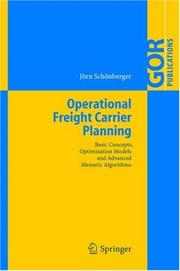
ISBN: 1280459050 9786610459056 3540263411 3540253181 3642064582 Year: 2005 Publisher: Berlin ; New York, NY : Springer,
Abstract | Keywords | Export | Availability | Bookmark
 Loading...
Loading...Choose an application
- Reference Manager
- EndNote
- RefWorks (Direct export to RefWorks)
This book represents the compilation of several research approaches on operational freight carrier planning carried out at the Chair of Logistics, University of Bremen. It took nearly three years from the first ideas to the final version, now in your hands. During this time, several persons helped me all the time to keep on going and to re-start when I got stuck in a dead end or when I could not see the wood for the trees. I am deeply indebted to them for their encouragement and comments. Prof. Dr. Herbert Kopfer, holder of the Chair of Logistics, introduced me into the field of operational transport planning. He motivated and supervised me. Furthermore, he supported me constantly and allowed me to be as free as possible in my research and encouraged me to be as creative as necessary. In addition, I have to thank Prof. Dr. Hans-Dietrich Haasis, Prof. Dr. Martin G. Mohrle and Prof. Dr. Thorsten Poddig. On behalf of all my colleagues, who supported me in numerous ways, I have to say thank you to Prof. Dr. Dirk C. Mattfeld, Prof. Dr. Christian Bierwirth, Henner Gratz, Prof. Dr. Elmar Erkens, Nadja Shigo and Katrin Dorow. They all helped me even with my most obscure and dubious problems. My family supported me all the time. They always showed me their trust and encouraged me continuously. Special thanks are dedicated to my parents Monika and Heinz-Jiirgen.
Freight and freightage --- Transportation --- Planning --- Mathematical models. --- Affreightment --- Cargo --- Freight handling --- Freight transportation --- Freightage --- Materials handling --- Freight --- Engineering. --- Operations research. --- Engineering Thermodynamics, Heat and Mass Transfer. --- Transportation. --- Operations Research/Decision Theory. --- Operational analysis --- Operational research --- Industrial engineering --- Management science --- Research --- System theory --- Construction --- Industrial arts --- Technology --- Thermodynamics. --- Heat engineering. --- Heat transfer. --- Mass transfer. --- Decision making. --- Deciding --- Decision (Psychology) --- Decision analysis --- Decision processes --- Making decisions --- Management --- Management decisions --- Choice (Psychology) --- Problem solving --- Public transportation --- Transport --- Transportation, Primitive --- Transportation companies --- Transportation industry --- Locomotion --- Commerce --- Communication and traffic --- Storage and moving trade --- Mass transport (Physics) --- Thermodynamics --- Transport theory --- Heat transfer --- Thermal transfer --- Transmission of heat --- Energy transfer --- Heat --- Mechanical engineering --- Chemistry, Physical and theoretical --- Dynamics --- Mechanics --- Physics --- Heat-engines --- Quantum theory --- Decision making --- Economic aspects
Book
ISBN: 1280313102 9786610313105 3540288538 Year: 2005 Publisher: Berlin : Springer-Verlag,
Abstract | Keywords | Export | Availability | Bookmark
 Loading...
Loading...Choose an application
- Reference Manager
- EndNote
- RefWorks (Direct export to RefWorks)
Automobiles are responsible for a substantial part of the world's consumption of primary energy, mostly fossil liquid hydrocarbons. The reduction of the fuel consumption of these vehicles has become a top priority. Many ideas to reach that objective have been presented. In most cases these systems are more complex than the traditional approaches. For such complex systems a heuristic design approach fails. The only way to deal with this situation is to employ model-based methods. This text provides an introduction to the mathematical modeling and subsequent optimization of vehicle propulsion systems and their supervisory control algorithms.
Automobiles --- Propulsion systems --- Motors --- Mathematical models. --- Autos (Automobiles) --- Cars (Automobiles) --- Gasoline automobiles --- Motorcars (Automobiles) --- Motor vehicles --- Transportation, Automotive --- Systems, Propulsion --- Engineering systems --- Engineering. --- Automotive Engineering. --- Engineering Thermodynamics, Heat and Mass Transfer. --- Control, Robotics, Mechatronics. --- Energy Systems. --- Transportation. --- Construction --- Industrial arts --- Technology --- Automotive engineering. --- Thermodynamics. --- Heat engineering. --- Heat transfer. --- Mass transfer. --- Control engineering. --- Robotics. --- Mechatronics. --- Energy systems. --- Public transportation --- Transport --- Transportation --- Transportation, Primitive --- Transportation companies --- Transportation industry --- Locomotion --- Commerce --- Communication and traffic --- Storage and moving trade --- Mechanical engineering --- Microelectronics --- Microelectromechanical systems --- Automation --- Machine theory --- Control engineering --- Control equipment --- Control theory --- Engineering instruments --- Programmable controllers --- Mass transport (Physics) --- Thermodynamics --- Transport theory --- Heat transfer --- Thermal transfer --- Transmission of heat --- Energy transfer --- Heat --- Chemistry, Physical and theoretical --- Dynamics --- Mechanics --- Physics --- Heat-engines --- Quantum theory --- Economic aspects
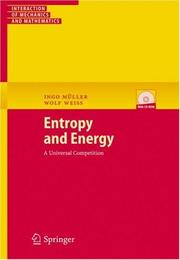
ISBN: 9783540242819 3540242813 3540323805 Year: 2005 Publisher: Berlin, Heidelberg : Springer Berlin Heidelberg : Imprint: Springer,
Abstract | Keywords | Export | Availability | Bookmark
 Loading...
Loading...Choose an application
- Reference Manager
- EndNote
- RefWorks (Direct export to RefWorks)
"Entropy and Energy- a Universal Competition" is a students textbook as well as a scientific monograph. The concepts of entropy and energy embody the effects of random walk in a body and of deterministic strife respectively, and are therefore often in competition. The book gives instructive examples from elementary thermodynamics and physico-chemistry and extrapolates the notion to non-standard thermodynamic subjects like shape memory, dissipation of the earth's atmosphere, and sociology. The works of the thermodynamic pioneers are presented, in particular Clausius, Carathéodory, Boltzmann, Gibbs, and Planck. The laws of thermodynamics and their limitations are discussed; also the pertinacious Gibbs paradox. The reader has numerous possibilities to influence the programs and thus develop an understanding for the thermodynamic principles.
Entropy. --- Thermodynamics. --- Force and energy. --- Chemistry, Physical and theoretical. --- Entropie --- Thermodynamique --- Force et énergie --- Chimie physique et théorique --- Entropy --- Thermodynamics --- Force and energy --- Chemistry, Physical and theoretical --- Physics --- Physical Sciences & Mathematics --- Chemistry, Theoretical --- Physical chemistry --- Theoretical chemistry --- Conservation of energy --- Correlation of forces --- Energy --- Mathematics. --- Applied mathematics. --- Engineering mathematics. --- Statistical physics. --- Dynamical systems. --- Engineering. --- Heat engineering. --- Heat transfer. --- Mass transfer. --- Applications of Mathematics. --- Engineering Thermodynamics, Heat and Mass Transfer. --- Statistical Physics, Dynamical Systems and Complexity. --- Engineering, general. --- Dynamics --- Mechanics --- Heat --- Heat-engines --- Quantum theory --- Chemistry --- Complex Systems. --- Statistical Physics and Dynamical Systems. --- Mathematical statistics --- Construction --- Industrial arts --- Technology --- Math --- Science --- Statistical methods --- Dynamical systems --- Kinetics --- Mathematics --- Mechanics, Analytic --- Statics --- Mass transport (Physics) --- Transport theory --- Heat transfer --- Thermal transfer --- Transmission of heat --- Energy transfer --- Mechanical engineering --- Engineering --- Engineering analysis --- Mathematical analysis --- Dynamics. --- Transmission.
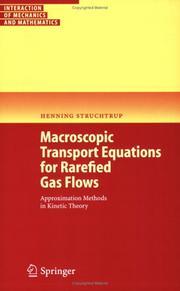
ISBN: 9783540245421 3540245421 3540323864 Year: 2005 Publisher: Berlin, Heidelberg : Springer Berlin Heidelberg : Imprint: Springer,
Abstract | Keywords | Export | Availability | Bookmark
 Loading...
Loading...Choose an application
- Reference Manager
- EndNote
- RefWorks (Direct export to RefWorks)
The well known transport laws of Navier-Stokes and Fourier fail for the simulation of processes on lengthscales in the order of the mean free path of a particle that is when the Knudsen number is not small enough. Thus, the proper simulation of flows in rarefied gases requires a more detailed description. This book discusses classical and modern methods to derive macroscopic transport equations for rarefied gases from the Boltzmann equation, for small and moderate Knudsen numbers, i.e. at and above the Navier-Stokes-Fourier level. The main methods discussed are the classical Chapman-Enskog and Grad approaches, as well as the new order of magnitude method, which avoids the short-comings of the classical methods, but retains their benefits. The relations between the various methods are carefully examined, and the resulting equations are compared and tested for a variety of standard problems. The book develops the topic starting from the basic description of an ideal gas, over the derivation of the Boltzmann equation, towards the various methods for deriving macroscopic transport equations, and the test problems which include stability of the equations, shock waves, and Couette flow.
Rarefied gas dynamics. --- Gaz raréfiés, Dynamique des --- Engineering. --- Mathematics. --- Statistical physics. --- Thermodynamics. --- Engineering Thermodynamics, Transport Phenomena. --- Applications of Mathematics. --- Statistical Physics. --- Physics and Applied Physics in Engineering. --- Rarefied gas dynamics --- Applied Physics --- Engineering & Applied Sciences --- Superaerodynamics --- Applied mathematics. --- Engineering mathematics. --- System theory. --- Heat engineering. --- Heat transfer. --- Mass transfer. --- Engineering Thermodynamics, Heat and Mass Transfer. --- Complex Systems. --- Engineering, general. --- Statistical Physics and Dynamical Systems. --- Fluid dynamics (Space environment) --- Gas dynamics --- Physics --- Mathematical statistics --- Chemistry, Physical and theoretical --- Dynamics --- Mechanics --- Heat --- Heat-engines --- Quantum theory --- Math --- Science --- Construction --- Industrial arts --- Technology --- Statistical methods --- Dynamical systems. --- Dynamical systems --- Kinetics --- Mathematics --- Mechanics, Analytic --- Force and energy --- Statics --- Engineering --- Engineering analysis --- Mathematical analysis --- Mass transport (Physics) --- Thermodynamics --- Transport theory --- Heat transfer --- Thermal transfer --- Transmission of heat --- Energy transfer --- Mechanical engineering --- Dynamics. --- Transmission.
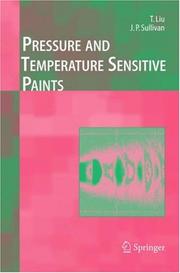
ISBN: 1280459069 9786610459063 3540266445 3540222413 3642060757 Year: 2005 Publisher: Berlin ; New York : Springer,
Abstract | Keywords | Export | Availability | Bookmark
 Loading...
Loading...Choose an application
- Reference Manager
- EndNote
- RefWorks (Direct export to RefWorks)
Luminescent molecule sensors, called pressure-sensitive paint (PSP) and temperature-sensitive paint (TSP), measure factors essential for understanding the aerodynamic performance and heat transfer characteristics of flight vehicles. They provide a powerful tool for experimental aerodynamicists to obtain a deeper understanding of the rich physical phenomena in complex flows around a flight vehicle. This book helps the reader to understand the physics and chemistry and the capabilities of PTP and TSP. It provides an overview of the wide scope of applications and explains the system requirements for using these sensors. The book also includes an extensive table of properties of PTP and TSP. As such, it is a thorough and up-to-date coverage of the underlying physics and applications of luminescent molecules designed for global pressure and temperature mapping.
Pressure-sensitive paint. --- Chemical detectors. --- Optical detectors. --- Fluid mechanics. --- Aerodynamics. --- Hydromechanics --- Continuum mechanics --- Aerodynamics, Subsonic --- Airplanes --- Streamlining --- Subsonic aerodynamics --- Dynamics --- Fluid dynamics --- Gas dynamics --- Pneumatics --- Aeronautics --- Wind tunnels --- Light-sensitive cells --- Light-sensitive detectors --- Light sensor photodevices --- Photodetectors --- Photodevices, Light sensor --- Photoelectric detectors --- Photosensors --- Detectors --- Optical transducers --- Optoelectronic devices --- Chemical sensors --- Chemical apparatus --- PSP (Paint) --- Air pressure --- Chemical detectors --- Paint --- Aerodynamics --- Measurement --- Equipment and supplies --- Hydraulic engineering. --- Engineering. --- Mechanics, applied. --- Engineering Fluid Dynamics. --- Engineering Thermodynamics, Heat and Mass Transfer. --- Automotive Engineering. --- Classical and Continuum Physics. --- Measurement Science and Instrumentation. --- Theoretical and Applied Mechanics. --- Applied mechanics --- Engineering, Mechanical --- Engineering mathematics --- Construction --- Industrial arts --- Technology --- Engineering, Hydraulic --- Engineering --- Fluid mechanics --- Hydraulics --- Shore protection --- Thermodynamics. --- Heat engineering. --- Heat transfer. --- Mass transfer. --- Automotive engineering. --- Continuum physics. --- Physical measurements. --- Measurement . --- Mechanics. --- Mechanics, Applied. --- Classical mechanics --- Newtonian mechanics --- Physics --- Quantum theory --- Measuring --- Mensuration --- Mathematics --- Metrology --- Physical measurements --- Measurements, Physical --- Mathematical physics --- Classical field theory --- Continuum physics --- Mass transport (Physics) --- Thermodynamics --- Transport theory --- Heat transfer --- Thermal transfer --- Transmission of heat --- Energy transfer --- Heat --- Mechanical engineering --- Chemistry, Physical and theoretical --- Mechanics --- Heat-engines
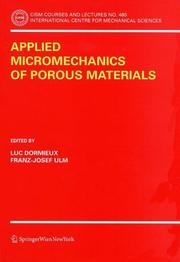
ISBN: 9783211380468 3211263624 9783211263624 3211380469 Year: 2005 Publisher: Vienna : Springer Vienna : Imprint: Springer,
Abstract | Keywords | Export | Availability | Bookmark
 Loading...
Loading...Choose an application
- Reference Manager
- EndNote
- RefWorks (Direct export to RefWorks)
Poromechanics is the mechanics of porous materials and is now a well established field in many engineering disciplines, ranging from Civil Engineering, Geophysics, Petroleum Engineering to Bioengineering. However, a rigorous approach that links the physics of the phenomena at stake in porous materials and the macroscopic behaviour is still missing. This book presents such an approach by means of homogenization techniques. Rigorously founded in various theories of micromechanics, these up scaling techniques are developed for the homogenization of transport properties, stiffness and strength properties of porous materials. The special feature of this book is the balance between theory and application, providing the reader with a comprehensive introduction to state-of-the-art homogenization theories and applications to a large range of real life porous materials: concrete, rocks, shales, bones, etc.
Engineering. --- Physics and Applied Physics in Engineering. --- Continuum Mechanics and Mechanics of Materials. --- Engineering Thermodynamics, Transport Phenomena. --- Structural Foundations, Hydraulic Engineering. --- Applied Geosciences. --- Biophysics/Biomedical Physics. --- Biomedical engineering. --- Materials. --- Ingénierie --- Génie biomédical --- Matériaux --- Micromechanics. --- Porous materials -- Mechanical properties. --- Porous materials. --- Porous media --- Geotechnical engineering. --- Biophysics. --- Biological physics. --- Thermodynamics. --- Heat engineering. --- Heat transfer. --- Mass transfer. --- Continuum mechanics. --- Engineering geology. --- Engineering --- Foundations. --- Hydraulics. --- Engineering, general. --- Engineering Thermodynamics, Heat and Mass Transfer. --- Geoengineering, Foundations, Hydraulics. --- Geotechnical Engineering & Applied Earth Sciences. --- Biophysics and Biological Physics. --- Geology. --- Materials --- Porosity --- Composite materials --- Solid state physics --- Microstructure --- Mechanics. --- Mechanics, Applied. --- Hydraulic engineering. --- Solid Mechanics. --- Biological and Medical Physics, Biophysics. --- Engineering, Hydraulic --- Fluid mechanics --- Hydraulics --- Shore protection --- Applied mechanics --- Engineering, Mechanical --- Engineering mathematics --- Classical mechanics --- Newtonian mechanics --- Physics --- Dynamics --- Quantum theory --- Construction --- Industrial arts --- Technology --- Engineering—Geology. --- Chemistry, Physical and theoretical --- Mechanics --- Heat --- Heat-engines --- Biological physics --- Biology --- Medical sciences --- Engineering, Geotechnical --- Geotechnics --- Geotechnology --- Engineering geology --- Flow of water --- Water --- Hydraulic engineering --- Jets --- Architecture --- Building --- Structural engineering --- Underground construction --- Caissons --- Earthwork --- Masonry --- Soil consolidation --- Soil mechanics --- Walls --- Civil engineering --- Geology, Economic --- Mass transport (Physics) --- Thermodynamics --- Transport theory --- Heat transfer --- Thermal transfer --- Transmission of heat --- Energy transfer --- Mechanical engineering --- Flow --- Distribution --- Details --- Geology --- Transmission.
| Listing 1 - 10 of 12 | << page >> |
Sort by
|

 Search
Search Feedback
Feedback About UniCat
About UniCat  Help
Help News
News